Beans & Bezels Beans & Bezels B&B
Disclaimer: this video/review was not sponsored by Ondřej Berkus or any other entity. This watch was generously loaned to me by my friend @watchsymmetry. Please check out his Instagram to see more photographs of this watch and other exceptional pieces.
Video
Review
Ondřej Berkus is equal parts watchmaker, mad scientist, and tinkerer. A self-taught watchmaker from the Czech Republic, he has been quietly creating extraordinary-looking watches and knives for about 15 years. I discovered his work when I began exploring independent watchmakers 4 to 5 years ago, and what struck me most was the almost steampunk, handmade aesthetic that defines his entire portfolio.
His watches range from simple three-handers to complex pieces like a one-second remontoire dead-beat central tourbillon. That really captures his approach: if you can imagine it and manage to secure a build slot, he’ll make it happen. There isn’t a complication or bold idea he hasn’t tried, and what I admire most is how stylistically cohesive his work remains. Still, it took time for me to appreciate his design philosophy.
At first, his watches looked like rough, unfinished projects straight out of a small tool-shed. But after learning how much of the process he handles himself, and how consistently he applies his visual language, my view changed quickly. After photographing and reviewing this piece, I gained even more respect for his ability to craft such soulful, artistic, and distinctive watches. While it may seem rough and imperfect at first glance, seeing it up close made me realize that this is central to his style.
The human touch is unmistakable, and the design seems to embrace irregularities and imperfections with intent, making the rugged, hand-built look incredibly appealing. When I mention those imperfections, I mean it in the best possible way, because in terms of quality, the watch feels surprisingly refined. It’s a unique experience: distinctive, original, and deeply artisanal.
This watch is part of a small series he made in the €6,000 to €8,000 range, aimed at those who may not want or be able to spend $200,000 on a bespoke tourbillon. I’m not sure if the series had an official name, but some people refer to it as the OB-1, so I’ll use that for now. This piece was loaned to me by my friend @watchsymmetry, and I’m grateful to experience and photograph watches like this thanks to generous people like him.
Let’s check it out!
Case
I measured the case to be 38.5 mm in diameter, 44.5 mm from lug tip to lug tip, and 10.85 mm in overall height. With this small series, Ondřej leveraged a combination of CNC and 3D-printed parts to bring costs down, one of which was the decision to use a 3D-printed titanium case. While some may view this as a drawback, I think it looks absolutely brilliant and aligns perfectly with the overall design ethos. Upon close inspection, you can see the rugged texture of the raw printed titanium, but it has been smoothed out enough that it doesn’t feel rough to the touch.

The case itself follows a fairly traditional tonneau design, with short lugs and a mid-case that curves slightly down toward the wrist. Interestingly, he opted for an 18 mm lug width, which is uncommon for watches around 39 mm in diameter, but it works well in this context. The flat sapphire crystal has sufficient anti-reflective coating for excellent legibility, and there is a 6.7 mm push-pull titanium crown at the 3 o’clock position that is easy to grip and operate.
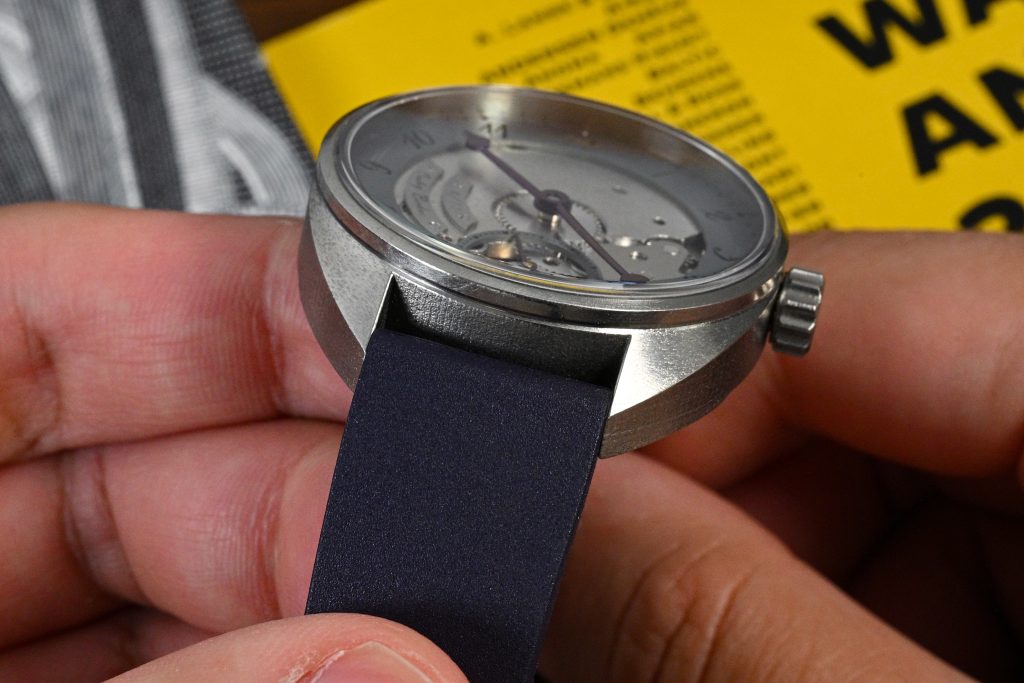
Flipping the watch over reveals an exhibition titanium case-back that offers a view of the beautifully executed movement, which we’ll explore later. I don’t know the exact water resistance rating of this watch, but I’d conservatively estimate it to be between 30 m and 50 m.
Dial
With this more “affordable” series, Ondřej sacrificed black-polished surfaces and exotic dial materials. The base movement appears to be a Unitas caliber, and the dial side of the watch is essentially the exposed movement top plate, featuring some skeletonization at 6 o’clock, along with a skeletonized hour ring that also wraps around the seconds sub-dial.
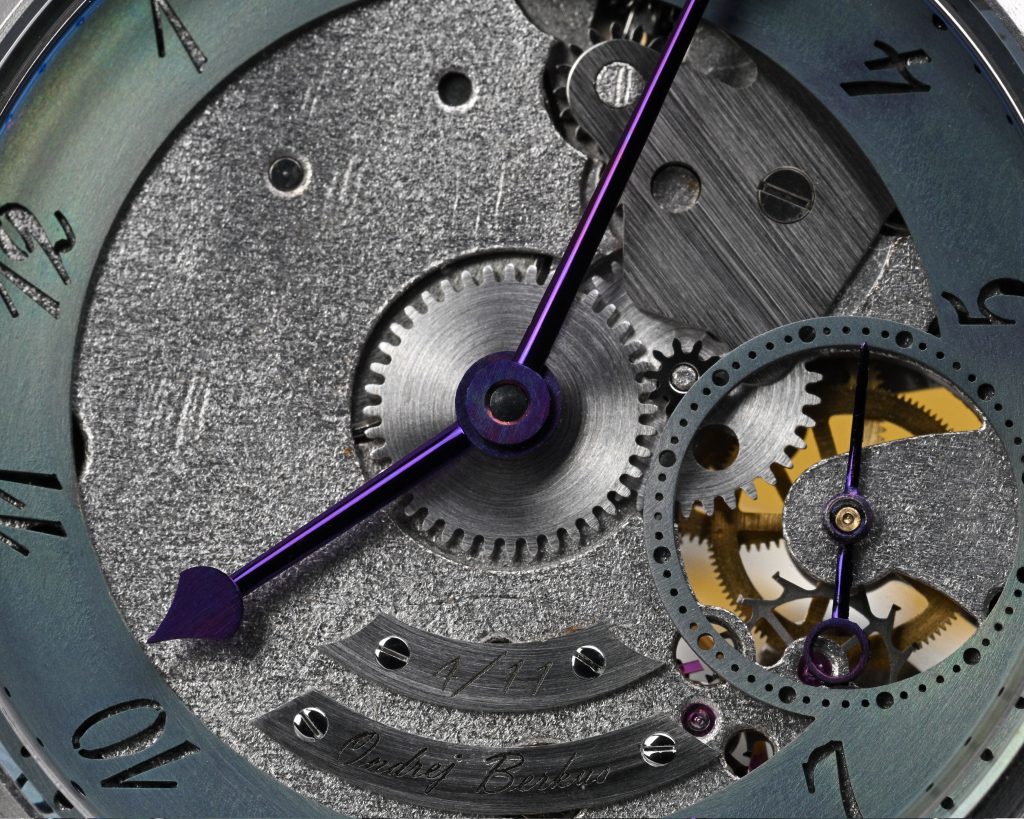
I believe customers in this batch were able to customize their dials to a reasonable extent, and I’ve seen some terrific designs within this series, including some with very vivid colors. This particular piece features a circular-brushed hour ring with hollowed-out numerals, and the color is a subtle sky blue that contrasts beautifully with the purple hands.
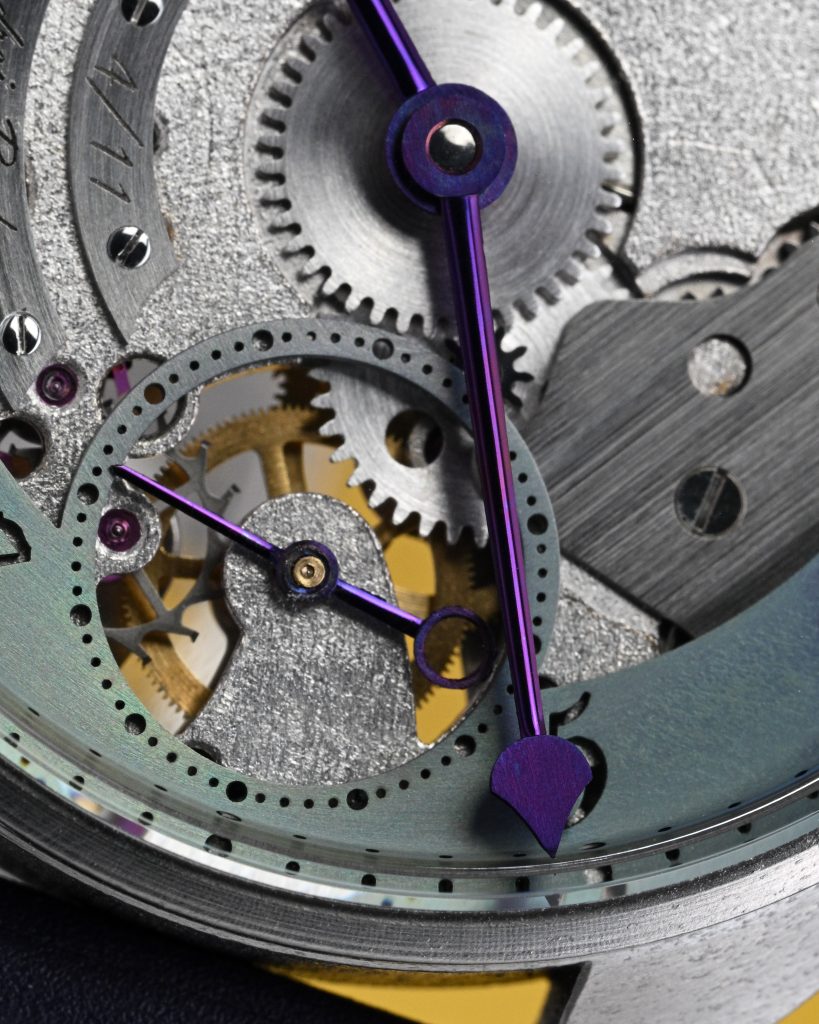
There is a nameplate and a serial number plate screwed into the movement at the 8 o’clock position, and the underlying texture of the dial is an intentionally aged and weathered metal finish. The real showstopper here is the thermally purpled hands, which, unlike those from many brands, are genuinely heat-colored. Achieving this shade of purple through traditional heat treatment is quite challenging. The hands are finished and tempered by hand, and the execution is excellent. The coloring isn’t perfect, but that imperfection is a sign of authentic handcrafting using traditional methods – unlike many colored hands that rely on chemical treatments. The hands also feature a combination of finishes, with brushed flat surfaces at the tip and base, and the remaining areas highly polished.
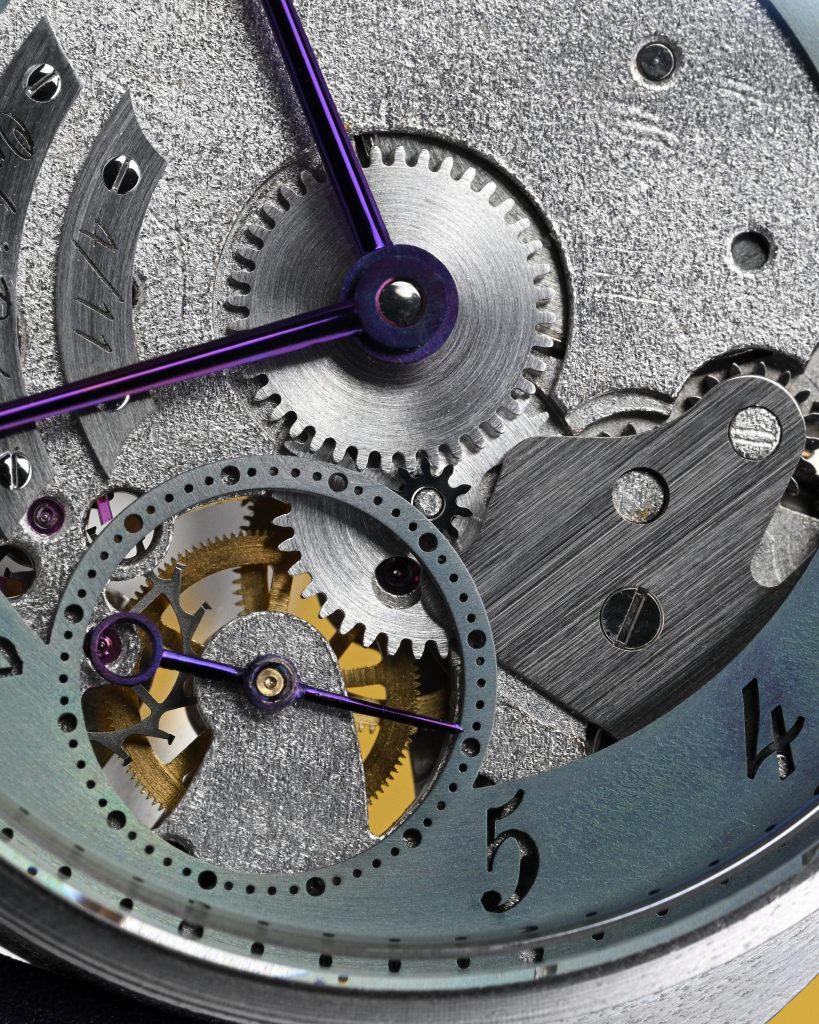
Personally, I think this dial looks amazing. As I mentioned earlier, it sits at the opposite end of the spectrum from the clinical perfection of a Grand Seiko dial, but I find it equally attractive and intriguing.
Movement
Like many watches in this category, the base caliber appears to be a Unitas 3/4 plate small seconds movement. While this watch was intended to trade off some hand-finishing in favor of a more accessible price point, it’s clear that considerable attention was still given to the movement. The base finish features a similar sandblasted texture, but the standard Unitas plates and bridges have been modified to create a more architecturally engaging appearance.
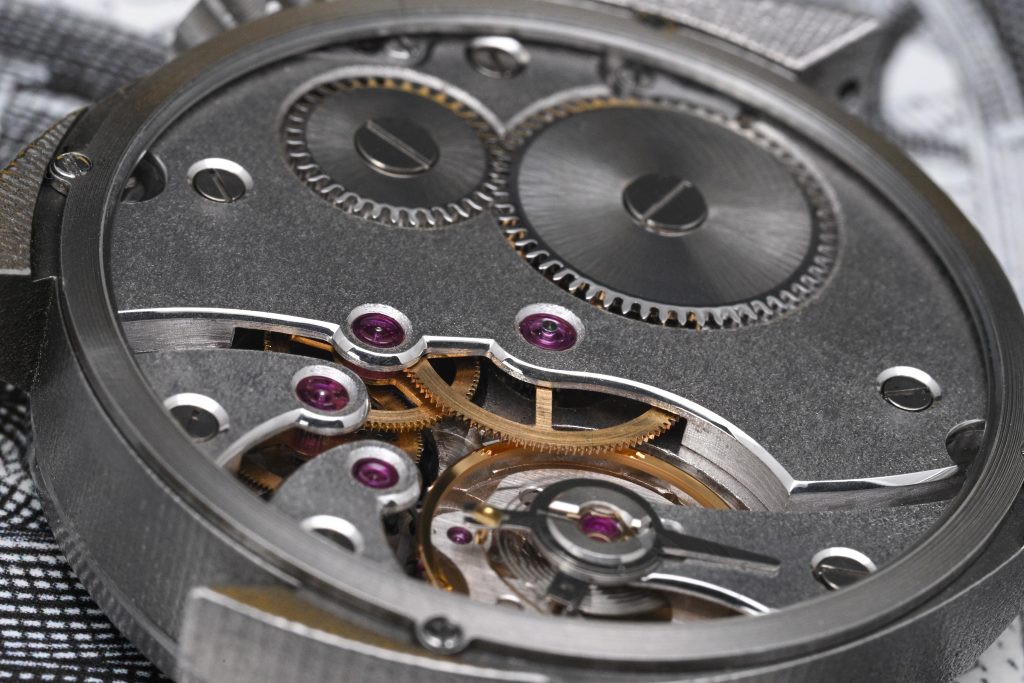
Winding this movement feels unlike any other watch I’ve handled: it is incredibly tactile, with a winding action that feels more like the crank of a high-end machine than a typical wristwatch. I’ve been told that Ondřej reworked the entire keyless works to achieve this effect.

There is a traditional Etachron-style regulator on a balance cock that features beautifully executed hand-polished bevels. These bevels continue through the escape wheel bridge and extend all the way to the 3/4 plate. Ondřej even included five well-executed interior angles in addition to the broad beveling. The teeth on the ratchet wheel also appear to be hand-polished. Truly impressive work here, especially at this price point.
I believe a great deal of effort went into this movement, even though it uses a relatively simple architecture based on mostly off-the-shelf components. However, it has been sufficiently reworked in both design and finishing to serve as a perfect complement to the case and dial.
On The Wrist
The 38.5 mm diameter case, with its 44.5 mm lug-to-lug length, fits great on my 6.75″ wrist. I initially thought the 18 mm lug width might be too narrow and dainty for my wrist, but in reality, it wore very well on this mildly tapered 18 mm Delugs CTS rubber strap. I think the strap’s thickness and limited 2mm taper help balance the watch’s proportions nicely.
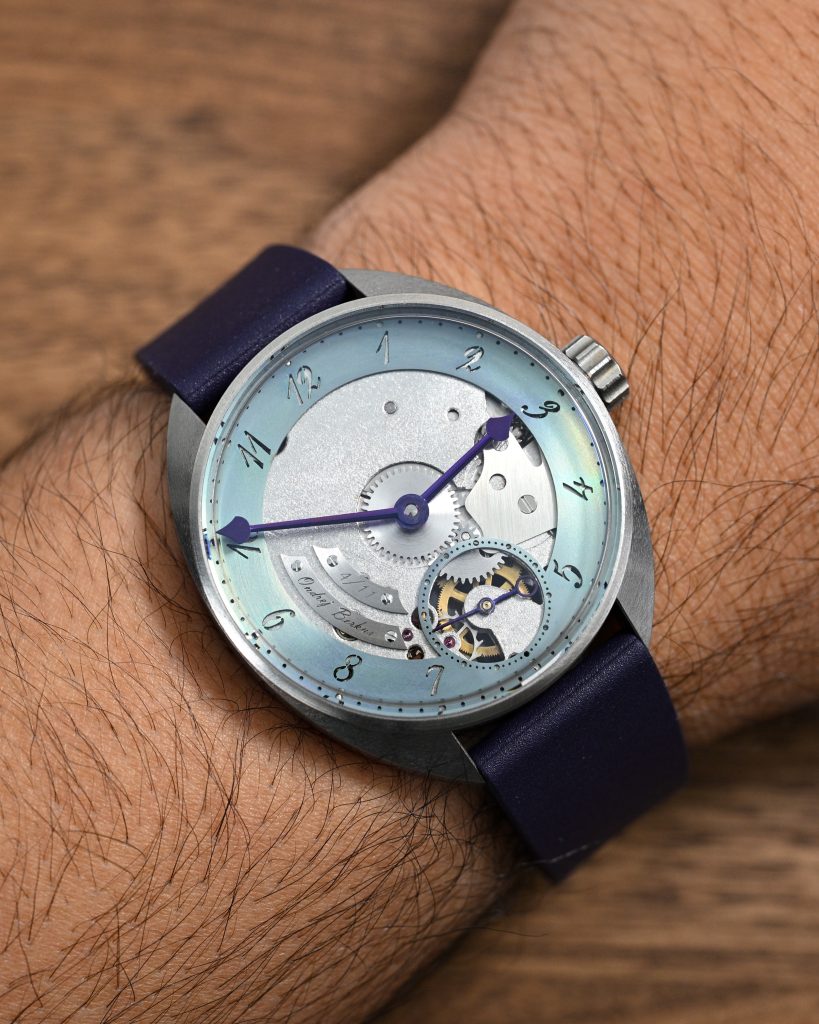
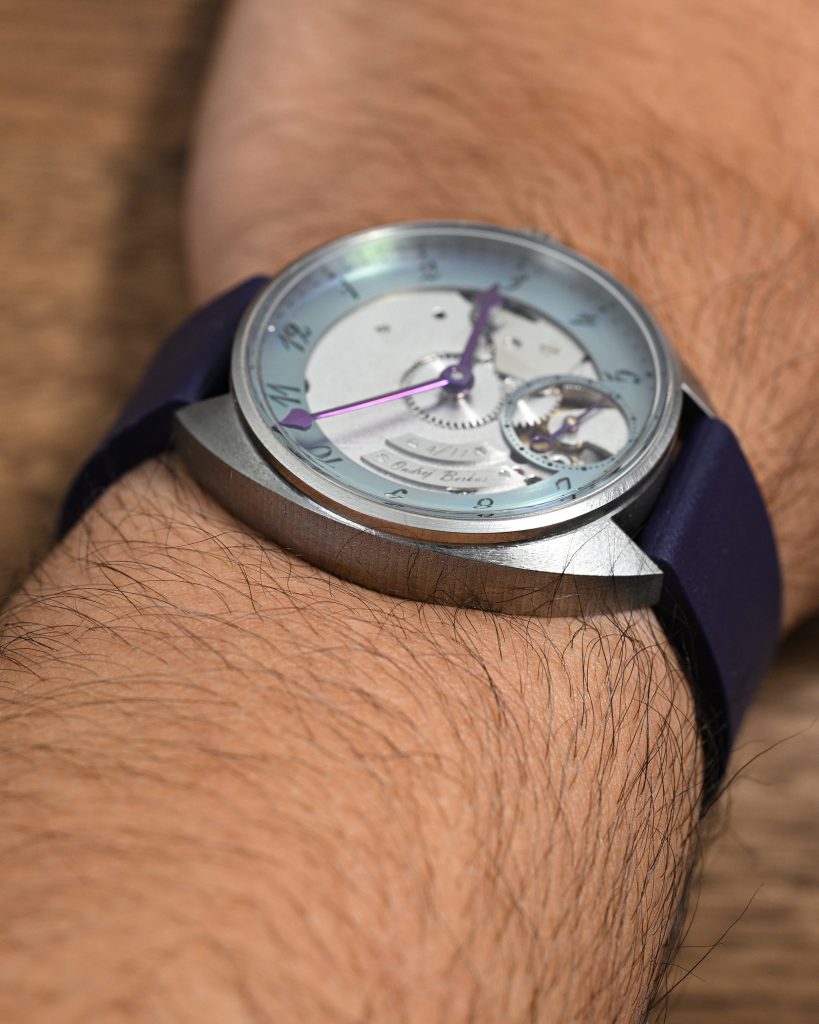
The 10.85 mm overall thickness looks bulkier than it actually is, as the case is essentially slab-sided with a relatively short lug-to-lug distance. However, it wears much more comfortably than it appears. The titanium case is light, and the watch has a wonderful wrist presence thanks to its pale titanium color and beautiful pop of purple.
Wrapping Up
I wasn’t expecting to love it as much as I do. I typically prefer dials that are clean, precisely finished, and exhibit the kind of soulless perfection you’d typically find on a Grand Seiko dial. But after spending a few days with this watch under my lens, I absolutely adore it. What I once saw as imperfections and a lack of skill, I now recognize as an intentionally industrial and handmade design style. I’ve photographed well over 300 watches at this point, and I know a shabbily put-together watch when I see one. This isn’t that… this is the work of a professional artist expressing himself exactly as he intends, and I have nothing but respect for this brand.
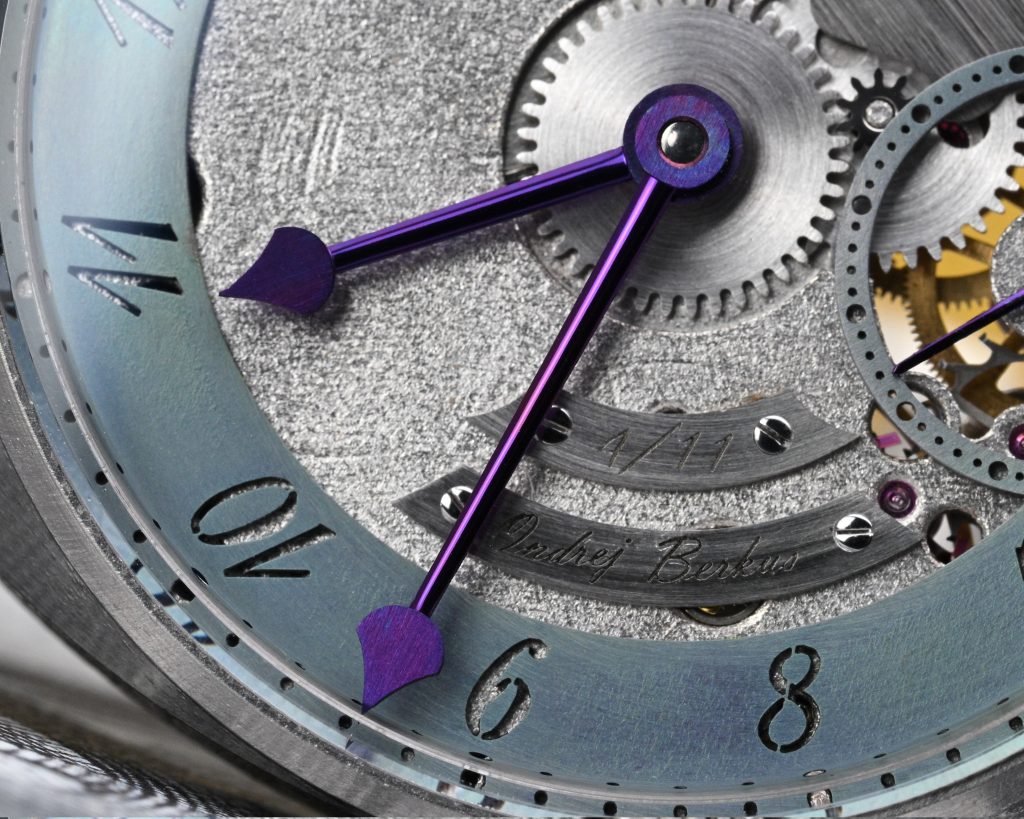
It takes remarkable courage to avoid the safe route of making a small seconds watch with a few variations of guilloché dials (Laine, Schwarz Etienne, Sartory Billard, Fleming, JN Shapiro, etc. – not that this is a bad thing – clearly the market wants this “look”, but I believe truly creative design is when an artist makes for him/herself and not for others), and instead develop a signature style that remains consistent even across 100 distinct and highly individual pieces. I look forward to the next Ondřej Berkus watch I get under my lens. I’m sure it will be radically different, yet comfortingly familiar.

